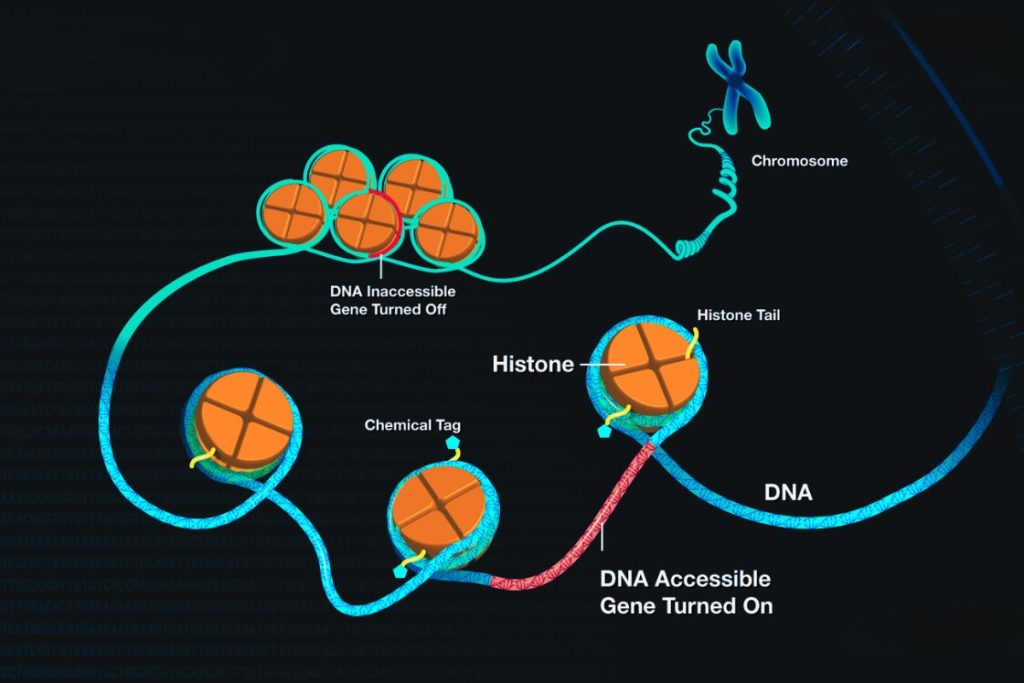
Yoga, a practice that had its roots in India over 5,000 years ago, has always been more than just physical exercises. It’s a comprehensive system aimed at cultivating mental, physical and spiritual well-being. Historically, yoga was a discipline that aimed to unite mind, body and spirit and create a harmonious balance between the individual and the universe.
Epigenetics, a term derived from the Greek word “epi” meaning “over” or “above,” is the study of changes in gene activity that aren’t accompanied by changes in the underlying DNA sequence. It’s like a system of switches that can turn genes on or off. This field has provided new insights into how our genes work and shown that our lifestyle, environment, and choices can affect the way our genes express themselves. Such changes in gene expression can affect our health, susceptibility to disease, and even our behavior.
Given that yoga has profound effects on our physical and mental health and that epigenetics shows how lifestyle can alter gene expression, a compelling question arises: Could yoga influence our genes? Exploring this junction between the ancient practice of yoga and the emerging science of epigenetics offers exciting possibilities. This interplay suggests that the benefits of yoga might extend beyond immediate relaxation and flexibility, potentially reaching as deep as our genes themselves.
Understanding the Basics of How Yoga Impacts Epigenetics
1. Yoga

a. The relevant two from the Eight Limbs of Yoga:
Yoga is structured around eight foundational pillars, known as the ‘Eight Limbs‘. While each is essential, for our context, two are particularly relevant:
- Asana: These are the physical postures or poses. When most people think of yoga, they’re thinking of asana. It’s about aligning and calming the body to prepare it for meditation.
- Dhyana: This refers to meditation or contemplative reflection. It’s the practice of focusing the mind and eliminating external distractions, helping practitioners connect more deeply with their inner selves.
b. Benefits of Yoga on Mental and Physical Well-being:
Yoga has long been praised for its positive impacts. Physically, it promotes flexibility, strength, and balance. Mentally, yoga can reduce stress, enhance concentration, and promote a sense of peace. Combined, these benefits contribute to an overall sense of well-being and health.
2. Epigenetics
a. Definition and Explanation:

Epigenetics is the study of gene activity changes that don’t alter the DNA sequence. Essentially, while our DNA provides the instructions, epigenetics determines which of those instructions get carried out. Genes can be ‘switched’ on or off based on epigenetic modifications.
b. Factors Influencing Epigenetic Changes:
Several factors can prompt these epigenetic shifts, including:
- Diet
- Stress
- Physical activity
- Aging
- Environmental toxins
c. Examples of Epigenetic Mechanisms:
There are key mechanisms through which epigenetic changes occur:
- DNA Methylation: It involves adding a methyl group to DNA, often leading to suppressed gene activity.
- Histone Modification: Histones are proteins around which DNA wraps. Modifying these can influence how tightly or loosely DNA is wound, affecting gene accessibility and activity.
- RNA-associated Silencing: This mechanism employs RNA molecules to regulate gene activity, often by silencing certain genes.
Understanding these basics sets the foundation for the deeper exploration of how yoga might interact with our genes on an epigenetic level.
The Science Behind Stress and Epigenetics

Stress, especially if it is ongoing, can lead to a number of epigenetic changes that can affect an individual’s health and well-being over time. Recognizing the connections provides greater insight into stress management and an understanding of its far-reaching effects.
1. How Stress Affects Gene Expression
Stress, whether acute or chronic, triggers a cascade of physiological responses in the body. At the genetic level, stress can alter the activity of certain genes, making them more active (expressed) or less active. These changes in gene expression can affect various cellular functions, including immunity, metabolism, and brain function.
2. The Role of Cortisol and Other Stress Hormones
Cortisol, often referred to as the “stress hormone,” plays a central role in stress. Cortisol, secreted by the adrenal glands, prepares the body to respond to stressful situations. However, a prolonged increase in cortisol levels due to chronic stress can have negative effects. In addition to cortisol, other hormones such as adrenaline come into play, increasing heart rate and blood pressure. Overall, these hormones, when imbalanced, can disrupt various physiological systems, leading to potential health risks.
3. Epigenetic Changes Resulting from Chronic Stress
Chronic stress doesn’t just produce immediate physiological responses—it can lead to long-term epigenetic changes. For instance:
- DNA Methylation: Chronic stress can alter methylation patterns in the DNA, leading to changes in gene activity. Some genes might get suppressed while others become more active.
- Histone Modifications: Chronic stress may also influence how DNA is packaged, affecting its accessibility and thus its activity.
- RNA-associated Mechanisms: The balance and function of various RNA molecules can be affected by prolonged stress, again leading to changes in how genes are expressed.
How Yoga Impacts Stress

Yoga offers a proactive approach to stress, equipping individuals with the techniques to both manage and reduce its effects, contributing to overall mental and physical health.
1. Reduction in Cortisol Levels Through Asanas and Meditation
Yoga, which includes both physical postures (asanas) and meditation exercises, has been shown to have an effect on cortisol levels. Regular yoga sessions can lower the amount of cortisol released in response to stress. The asanas promote physical relaxation, while meditation helps calm the mind. Together, they counteract the body’s stress response and reduce the overall release of cortisol.
2. Activation of the Parasympathetic Nervous System
The human nervous system consists of two main divisions: the sympathetic, which triggers the ‘fight or flight’ response, and the parasympathetic, which controls the ‘rest and digest’ functions. Yoga, especially through deep breathing techniques, stimulates the parasympathetic nervous system. This activation promotes relaxation, slows the heart rate, and lowers blood pressure, effectively countering the effects of stress and fostering a state of calm.
3. The Holistic Approach of Yoga in Managing and Reducing Stress
Yoga is not just a set of exercises; it is a holistic discipline that encompasses body, mind and spirit. Through its comprehensive practises — from controlled breathing and postures to meditation and ethics — yoga offers a multi-faceted approach to stress management. Participants often experience increased mindfulness, a heightened awareness of their bodies, and a greater sense of connection to their surroundings. This holistic understanding of well-being provides individuals with tools to manage daily stress, both immediate and chronic.
Direct and Indirect Epigenetic Impacts of Yoga
The practice of yoga wields both direct and indirect influences on our epigenetic landscape. Whether through immediate shifts in gene expression or through the broader physiological benefits it offers, yoga stands as a powerful tool in shaping our genetic health.
1. Studies Suggesting Direct Epigenetic Changes Induced by Yoga and Meditation
Research into the effects of yoga and meditation on gene expression has unveiled compelling results. Several studies have shown that consistent yoga and meditation practices can lead to direct epigenetic changes. For instance, there have been observed alterations in genes related to inflammation. Specifically, some genes that promote inflammation get suppressed, while others that reduce inflammation become more active. This direct modulation of genetic activity underscores the profound influence that mind-body practices can have at the molecular level.
2. Indirect Effects
Beyond direct changes to DNA methylation or histone modifications, yoga promotes physiological shifts that can indirectly influence epigenetic mechanisms.
- Improved Sleep: Yoga enhances sleep quality. As sleep plays a vital role in cellular repair and regulating gene activity, better sleep patterns can lead to favorable epigenetic adjustments.
- Better Diet: Many who practice yoga develop heightened body awareness, often leading to healthier dietary choices. Nutrition, as we know, significantly impacts epigenetic modifications.
- Reduced Stress: As previously discussed, yoga effectively reduces stress, and lowered stress levels bring about a cascade of positive physiological effects. Given that chronic stress can lead to adverse epigenetic changes, managing and reducing it through yoga indirectly benefits our genes.
Deep Dive into Meditation and Epigenetics

Meditation, whether short-term or long-term, directly and indirectly, modulates our genetic expression. Understanding these mechanisms offers a profound insight into how a practice rooted in ancient wisdom aligns with modern scientific revelations.
1. Overview of Meditation Types
Meditation, a cornerstone of many ancient traditions, exists in various forms:
- Mindfulness: This meditation emphasizes staying present and fully engaging with the here and now. It involves observing one’s thoughts and emotions without judgment.
- Transcendental Meditation: Originating from the Vedic tradition, this technique involves silently repeating a specific mantra, allowing the practitioner to settle into a deep state of relaxation and awareness.
- Focused Meditation: As the name suggests, this method revolves around focusing on a single point. This could be the breath, a mantra, or even the flicker of a candle flame.
While these are just a few examples, they represent the diversity and depth of meditation practices available.
2. Studies Linking Meditation to Epigenetic Changes
Research has increasingly shown that meditation can lead to epigenetic alterations. For instance, studies on long-term meditators have indicated changes in genes associated with inflammation, cellular health, and even aging. Furthermore, some research has demonstrated that even short-term meditation interventions can influence the methylation status of specific genes, emphasizing meditation’s potential rapid impact on our epigenetic profile.
3. Exploration of the Mechanisms: How Does Meditation Impact Gene Expression?
While the full spectrum of mechanisms remains an area of ongoing research, several pathways have been identified:
- Stress Reduction: Meditation reduces stress, and as previously discussed, lowered stress leads to a decrease in cortisol levels. Reduced cortisol can influence the activity of certain genes, especially those associated with inflammation and immune function.
- Hormonal Balance: Meditation can balance various hormones in the body. For example, it can increase melatonin levels, which is crucial for sleep and cellular repair—both of which can influence gene expression.
- Neuroplasticity: Meditation has been shown to affect brain structure and function, promoting neuroplasticity. Changes in neural pathways and networks can, in turn, affect the signaling pathways that influence gene expression in various tissues.
Practical Takeaways From the Understanding of How Yoga Impacts Epigenetics
Yoga and meditation offer powerful tools for enhancing our well-being, both mentally and physically. Incorporating them into daily life can offer a sanctuary of calm in our often hectic lives. However, remember to maintain a holistic and balanced approach, recognizing that our well-being is multifaceted and requires nurturing from various angles.
1. How to Incorporate Yoga and Meditation into Daily Life
Starting with yoga and meditation need not be daunting. Here’s how you can seamlessly integrate them:
- Consistency Over Duration: Instead of a lengthy session, begin with just 10 minutes daily. The key is to establish a routine.
- Morning or Evening Ritual: Use yoga or meditation as a way to start or end your day, creating a calming transition between daily activities.
- On-the-Go: Short breathing exercises or mindfulness moments can be practiced even during breaks at work or while commuting.
2. Recommendations for Those New to the Practices
If you’re just beginning, here are some pointers to guide you:
- Start Slow: Start with basic yoga poses and short meditation sessions. Gradually extend your practice as you become more comfortable.
- Seek Guidance: Consider joining a local class or using online classes & tutorials. An instructor can offer personalized guidance and correct postures.
- Listen to Your Body: It’s essential to understand your body’s signals. If something feels uncomfortable, take a step back and adjust.
- Maintain a Journal: Track your progress, jot down how you feel post-practice, and note any changes in your physical or mental well-being. This can be motivating and insightful.
3. Encouraging a Balanced Approach
While the benefits of yoga and meditation are manifold, it’s essential to recognize them as part of a broader toolkit for well-being:
- Holistic Health: Complement your yoga and meditation routine with a balanced diet, regular physical activity, and adequate sleep.
- Seek Additional Support: In times of acute stress or emotional turmoil, consider seeking additional professional help or counseling.
- Stay Open: The world of well-being is vast. Stay open to exploring other avenues of self-care, from hobbies to therapies to spending time in nature.
To Conclude
The intricate interplay between yoga, meditation, and our genes is evidence of the profound impact these ancient practices can have on modern life. The new findings underscore the potential of yoga and meditation to influence our epigenetic landscape and reshape gene expression to promote health and well-being.
Although the findings to date are promising, the field of epigenetics, yoga, and meditation is vast and largely unexplored. We still have much to find out about the depth and breadth of their interplay. Continued research in this area won’t only confirm existing findings, but also pave the way for new insights that can benefit all of humanity.
The transformative power of yoga and meditation isn’t just found in academic articles or research labs; it can be experienced by everyone. To truly understand the depth of their influence, you must engage with the practices firsthand. So take a moment, unroll the yoga mat, or find a quiet place to meditate. Embark on this journey of self-discovery, and let your own experiences paint a vivid picture of the potential of these practices.
In summary, the fusion of ancient wisdom and modern science offers a promising path to holistic health. May this exploration inspire you to go deeper, seek balance, and embrace the transformative potential of yoga and meditation in your life.




